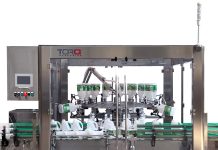Tightness problems in wine bottle corking in connection to the use of natural corks.
The bottles showing loss of wine (ullage) are generically defined as “leaking bottles”, yet a distinction must be made between “leakage” and “transudation”. “Transudation” or “Seeping” is the process in which the wine penetrates between the glass and the cork with a loss of product of little importance that can be temporary or continue over time or cease thanks to the refilling of the escape routes by the substances composing the dry extract of the wine. “Leakage” is a major defect with percolation through the cork or along a crease of it. Said phenomenon is difficult to be interrupted and leads to an important loss of wine. The above inconveniences cause a number of alterations in the aspect of the bottle and the quality of the wine: – Presence of humidity under the capsule with the risk of anomalous tastes in the wine; – Alteration of capsule and label; – Degradation of the wine (oxidation, sourness). This defect in the tightness generally depends on various factors connected to the variables listed below.
Choice of the bottle with as perfect neck profile as possible
The inner surface of the bottle neck must be free from irregularities which could prevent correct closure; the inner profile must be a slightly conical and correspond to the diameters requested for the different types. The flaring, i.e. the difference between the diameter of the bottle neck at the lower base of the cork and that at the mouth, related to the major diameter and expressed in percentage allows the evaluation of the regularity of the inner profile of the neck and the possible risk of leakage independently from the type of cork used. The Stazione Sperimentale del Sughero (Cork Experimental Station) proposed a flaring below 2.5%, while Portugal suggests a value under 5.0%. In practice it is advisable to avoid using bottles with necks having a flaring over 10%. Needless to say, if some bottle show major irregularities of the neck, other inconveniences, besides the phenomenon of leakage, may occur.
Strict selection of the corks
The official dimensions of the corks are defined by U.N.I. 2097-1987 and I.S.O. 3863-1980 standard. In practice every company supplies the wineries with the corks they request. When the diameter of the bottle at the level of the mouth is 17.5 ± 0.4 mm (“Italia neck”), it is advisable to use a cork made of a single piece of 24 mm diameter, while the same type of cork with 26mm diameter is used only for bottles with “CETIE neck”, i.e. with a mouth of 18.5 + 0.5 mm. The optimal difference between the diameter of the cork and the inner diameter of the bottle neck to june 2007 19 guarantee a good tightness is not lower than 5 mm along the whole height of the cork.
Control of the liquid level
The filling level in the bottle must be calculated depending on the type of bottle, the temperature of the wine, the length of the cork and the nominal volume of the bottle in compliance with L. D. CEE n. 451, 3rd July 1976. The thermal dilatation of the wine depends on its alcohol content. If the bottling is made at a temperature different from 20° C, a precise calculation of the filling level is required. The rise of the wine level wine during storage can cause the following phenomena:
- Reduction of the empty volume (air chamber) inside the bottle;
- Increase in the internal pressure of the air chamber;
- Transudation of wine between cork and bottle and consequently seeping or leakage A computerized control system regulating the level of the wine to let sufficient headspace is ever more often used in the modern filling machines; with this regulation a sufficient headspace is let free to contain any volumetric variations.






